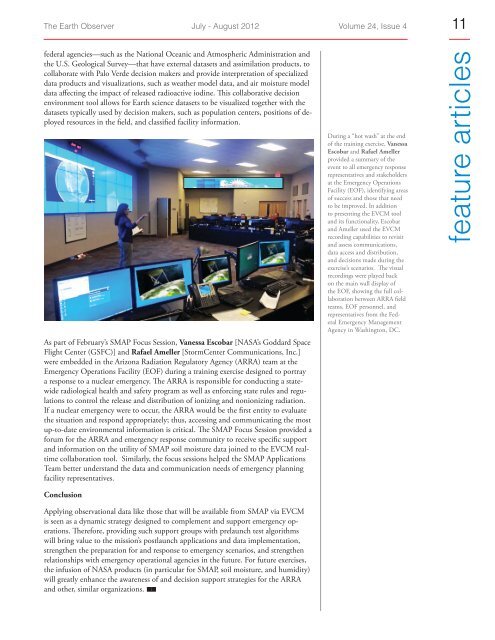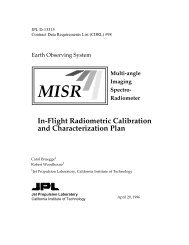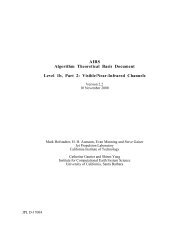Download - NASA's Earth Observing System
Download - NASA's Earth Observing System
Download - NASA's Earth Observing System
You also want an ePaper? Increase the reach of your titles
YUMPU automatically turns print PDFs into web optimized ePapers that Google loves.
The <strong>Earth</strong> Observer July - August 2012 Volume 24, Issue 4 11<br />
federal agencies—such as the National Oceanic and Atmospheric Administration and<br />
the U.S. Geological Survey—that have external datasets and assimilation products, to<br />
collaborate with Palo Verde decision makers and provide interpretation of specialized<br />
data products and visualizations, such as weather model data, and air moisture model<br />
data affecting the impact of released radioactive iodine. This collaborative decision<br />
environment tool allows for <strong>Earth</strong> science datasets to be visualized together with the<br />
datasets typically used by decision makers, such as population centers, positions of deployed<br />
resources in the field, and classified facility information.<br />
As part of February’s SMAP Focus Session, Vanessa Escobar [NASA’s Goddard Space<br />
Flight Center (GSFC)] and Rafael Ameller [StormCenter Communications, Inc.]<br />
were embedded in the Arizona Radiation Regulatory Agency (ARRA) team at the<br />
Emergency Operations Facility (EOF) during a training exercise designed to portray<br />
a response to a nuclear emergency. The ARRA is responsible for conducting a statewide<br />
radiological health and safety program as well as enforcing state rules and regulations<br />
to control the release and distribution of ionizing and nonionizing radiation.<br />
If a nuclear emergency were to occur, the ARRA would be the first entity to evaluate<br />
the situation and respond appropriately; thus, accessing and communicating the most<br />
up-to-date environmental information is critical. The SMAP Focus Session provided a<br />
forum for the ARRA and emergency response community to receive specific support<br />
and information on the utility of SMAP soil moisture data joined to the EVCM realtime<br />
collaboration tool. Similarly, the focus sessions helped the SMAP Applications<br />
Team better understand the data and communication needs of emergency planning<br />
facility representatives.<br />
During a “hot wash” at the end<br />
of the training exercise, Vanessa<br />
Escobar and Rafael Ameller<br />
provided a summary of the<br />
event to all emergency response<br />
representatives and stakeholders<br />
at the Emergency Operations<br />
Facility (EOF), identifying areas<br />
of success and those that need<br />
to be improved. In addition<br />
to presenting the EVCM tool<br />
and its functionality, Escobar<br />
and Ameller used the EVCM<br />
recording capabilities to revisit<br />
and assess communications,<br />
data access and distribution,<br />
and decisions made during the<br />
exercise’s scenarios. The visual<br />
recordings were played back<br />
on the main wall display of<br />
the EOF, showing the full collaboration<br />
between ARRA field<br />
teams, EOF personnel, and<br />
representatives from the Federal<br />
Emergency Management<br />
Agency in Washington, DC.<br />
feature articles<br />
Conclusion<br />
Applying observational data like those that will be available from SMAP via EVCM<br />
is seen as a dynamic strategy designed to complement and support emergency operations.<br />
Therefore, providing such support groups with prelaunch test algorithms<br />
will bring value to the mission’s postlaunch applications and data implementation,<br />
strengthen the preparation for and response to emergency scenarios, and strengthen<br />
relationships with emergency operational agencies in the future. For future exercises,<br />
the infusion of NASA products (in particular for SMAP, soil moisture, and humidity)<br />
will greatly enhance the awareness of and decision support strategies for the ARRA<br />
and other, similar organizations. ••







